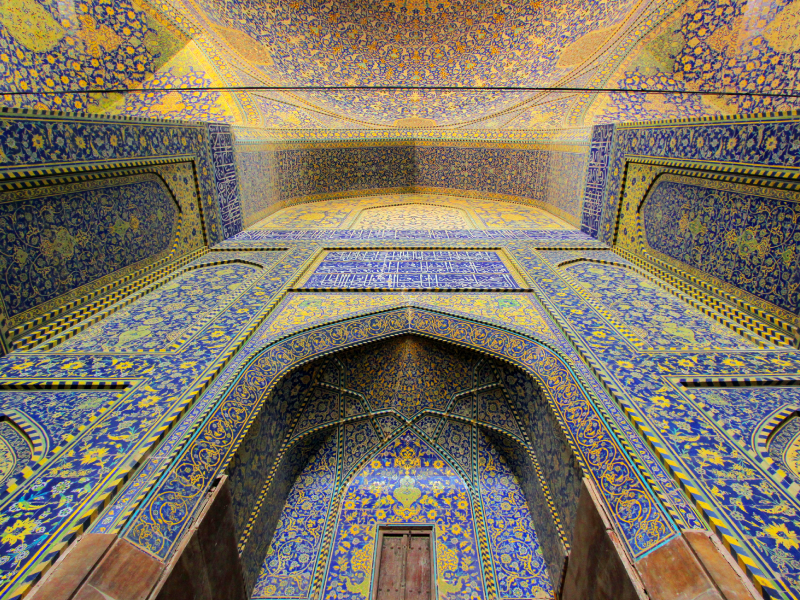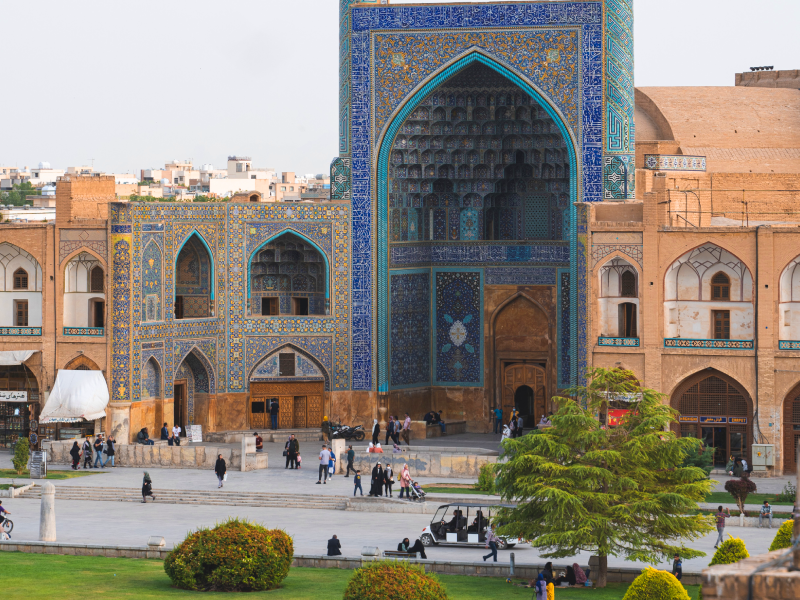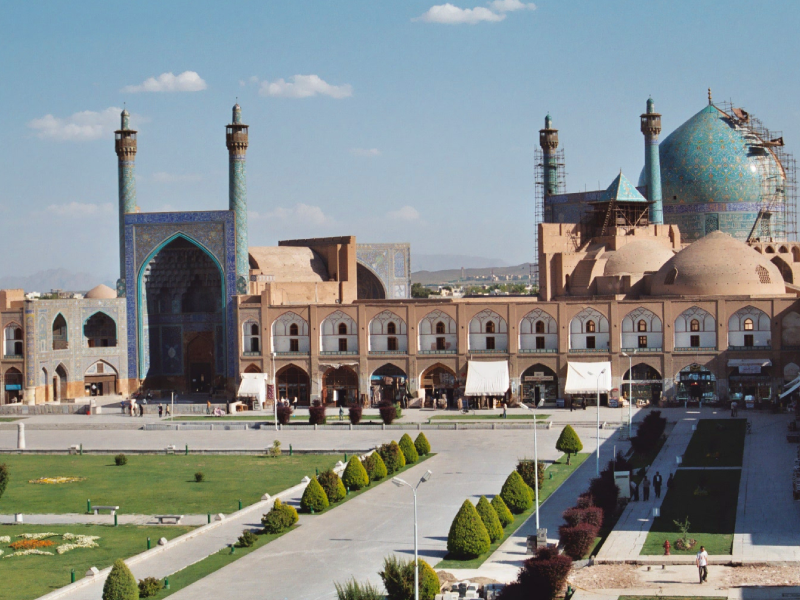Shah Mosque, Isfahan: Photos, History, Architecture
Isfahan is the most popular tourist destination in Iran, which attracts countless tourists from all over the world every year. One of the best historical monuments of Isfahan is Naqsh Jahan Square, a large complex with attractive architecture consisting of different parts. Shah Mosque is one of the interesting buildings of this historical complex, which is located on the south side of the square. With its exquisite tilework, intricate geometric patterns, and harmonious proportions, the mosque is not just a place of worship but a masterpiece that contains the artistic and spiritual gem of Iran. Let us together visit one of the best places to visit in Isfahan.
Shah Mosque History
The history of the Shah Mosque, also known as Masjid-e Shah, dates back to the Safavid era. It was built by Shah Abbas I, and its construction began in the year 1020 AH (1611 CE), coinciding with the twenty-fourth year of his reign. The remarkable Kashan-style tilework of this mosque was finally completed in the year 1025 AH. The Shah Mosque, or Imam Mosque of Isfahan, was famous for its dimensions, decorations, and architectural artistry and was considered one of the most exceptional historical structures of its time. Even today, this mosque continues to be regarded as one of the most beautiful mosques in the world.
The creation of such a grand project required a considerable amount of time. As a result, different sections of the Shah Mosque bear historical monuments from the era of various successors to Shah Abbas Safavi. In one part of the mosque, the year 1077 AH is evident, marking the final year of Shah Abbas II’s rule. In another section, the year 1078 AH is visible, corresponding to the first year of Shah Suleiman’s rule. Moreover, the year 1095 is inscribed in another part of the mosque, indicating the reign of the next successors within the Safavid government. This shows that the intricate decorations and tilework of the Shah Mosque have been done over many years.
Shah Mosque Isfahan Architecture
Shah Abbas Safavi, a ruler of the past, saw architecture as a way to compete with the Ottoman Empire. He always ordered the construction of impressive buildings around the main square of Isfahan, called Naghshe Jahan Square. One of the most splendid buildings was the Shah Mosque. Compared to other mosques in Isfahan and even similar ones like Vakil Mosque in Shiraz, the Shah Mosque looked much bigger and grander. Even by looking at the Shah Mosque Isfahan images, you can easily realize its greatness and glory. It has always been one of Iran’s most important mosques throughout history.
One striking feature of its architecture is the presence of a central dome chamber. This was a common feature in Safavid-era mosque construction. Before the Safavids, mosques had columned prayer halls instead of domes. The courtyard of the Shah Mosque, with its dome chamber, is about 22.5 meters by 22.5 meters. Around the dome, there are four iwans (vaulted chambers), which are another distinctive feature of Iranian mosque architecture.
The mosque has a marble mihrab (prayer niche) that is considered one of the most beautiful mihrabs among mosques of its time. Besides that, there are two schools named Suleimaniyeh and Nasiriyyeh on its sides. To save time and money, a technique called seven-color tilework was used to decorate its walls. Skilled calligraphers, woodcarvers, and stonecutters worked on other parts of the building. Despite having many artisans, the mosque’s exterior and interior have a unified and cohesive appearance. One of Shah Mosque Isfahan Facts is that during its construction, 18 million bricks and 475 thousand tiles were used, which shows its greatness. Additionally, underneath the walls, large and uniform pieces of carved marble were utilized.
Why is Shah Mosque Isfahan Important?
The Shah Mosque in Isfahan is a very important place for a few reasons. First, it is a special spot where people used to go to pray. Inside, there is a special thing called the mihrab that helps people know which way to pray. People would gather here to talk to God and do their prayers, making it a meaningful place for their faith.
Second, the Shah Mosque is super beautiful and artistic. It is like a big piece of art with colorful tiles and fancy designs. Back in the old days, the kings wanted to show off their culture and creativity, so they made this mosque really special. The patterns on the walls and the dome are like nothing else, making it a unique place to visit.
Lastly, the Shah Mosque tells a story about history. It was built a long time ago, during the time of the kings. It is not just about religion and art but also the past of the country. People can learn about how things were in those days by looking at the mosque. So, the Shah Mosque is important for its role in religion, its stunning beauty, and its connection to the history of Isfahan and Iran.
What Was the Shah Mosque Used For?
The Shah Mosque held a significant role in Isfahan. One of its primary purposes was to serve as a place of worship. Inside its walls, people gathered to pray, facing the mihrab, a special niche that pointed towards the direction of Mecca. This spot helped guide worshippers during their prayers, connecting them to their faith.
However, the importance of the Shah Mosque transcended religious practices. It was not just a religious building, it also stood as a symbol of artistic and cultural expression. The mosque showcased breathtaking architecture, intricate tilework, and fascinating patterns that blended with its religious function. The mosque’s majestic presence was not just about prayer; it was an embodiment of the creative spirit of the time, a place where art and religion were side by side.
The Shah Mosque was a center where spirituality and culture came together. People came to find solace in their beliefs while also appreciating the artistic masterpieces surrounding them. It was a multi-faceted space that hosted prayers, discussions, and awesome encounters with the artistry of the era. In essence, the Shah Mosque was a living testimony to the harmonious integration of religion, art, and social life.
Shah Mosque Dome
One of the most captivating features of the Shah Mosque is its main dome. When you stand beneath it, you will be amazed by the intricate tilework. The fact that they created such beautiful tiles around 400 years ago shows the world the beauty of Iranian art. Moreover, the geometric shape of the mosque’s dome is flawless, which is like a miracle in the world of architecture. Apart from all these wonders, it is important to mention the fascinating sound reflection underneath the main dome of the mosque.
When you stand right at the center of this dome, the sound echoes perfectly. This has turned into an entertaining and touristy attraction. Some tourists stand beneath the dome and sing, enjoying the echo of their voices. Others try making different sounds to experience the reflections.
It is interesting to know that this design was intentional and clever. In fact, the person who used to call the prayer (muezzin) would stand under this dome so that the sound of the call to prayer would spread throughout the whole mosque. Now, after 400 years, this phenomenon has become a tourist attraction. So, if you see people tapping their feet under this dome, they are actually trying to hear the echo of their footsteps.
Shah Mosque Minarets
If you look at mosque architecture, most mosques have two minarets. In fact, a minaret symbolizes the two divine ropes, which are the Quran and the family of the Prophet. However, in Shah Mosque, four minarets were used. The reason for this is the mosque’s tricky layout, which is based on the four main geographical directions. On the other hand, all mosques should be built facing the direction of Mecca, which made designing and building the mosque a bit difficult.
So, the architects of Shah Mosque solved this challenge by creating two tall minarets that are 48 meters high at the main entrance, called the Qeysarieh. Also, behind these two big minarets, you can see two shorter minarets that are 42 meters high. Interestingly, all four minarets have a little room called a “goldestan” or a minaret balcony, but only the shorter minarets were used for calling the prayer (adhan). The reason was that the taller minarets overlooked the royal precinct. That is why only the smaller minarets were used for the muezzin to call the prayer.
The Best Time to Visit the Shah Mosque
The best time to explore this architectural masterpiece is during the cooler months of spring and fall, around March to May or September to November. The weather during these seasons is comfortably mild, allowing you to leisurely explore the mosque’s intricate details and the surrounding attractions without the scorching heat of summer or the cold of winter. Additionally, early mornings and late afternoons provide softer sunlight that enhances the mesmerizing tilework and illuminates the beauty of the architecture; the most beautiful Shah Mosque photos were also taken at this time. Timing your visit with these pleasant weather conditions and the gentle play of light will undoubtedly elevate your experience at the Shah Mosque to an unforgettable level.
Shah Mosque Location
The Shah Mosque is located on the south side of Naqsh Jahan Square in Isfahan and within the boundaries of the Safavid Government House. This amazing mosque is next to the important buildings of the Safavid era, such as Ali Qapu and Sheikh Lotfollah Mosque. The main entrance of this mosque is located on the south side of the square, and other entrances are in the neighborhoods around the building for faster and easier access for the people of the neighborhood.
Access to the building is easy from Ostandari Street and Gozar Saadi alleys and Posht Matbakh to the square. You can reach the north side of the square by walking or using electric cars from Hafez and Sepeh streets. The nearest metro and bus station is Imam Hossein Square station, and the remaining distance from there to the square can be reached on foot or by taxi. In addition to public parking lots along the streets leading to the square, there are several private parking lots.
Shah Mosque Nearby Attractions
With one look at the Shah Mosque Isfahan map, you can see that this historical building has a great location, and many other historical attractions are located near it. A short walk away is Naqsh Jahan Square, a huge public space surrounded by architectural wonders. Here, you will find the Ali Qapu Palace, a stunning palace with intricate façades and an enchanting music room. Right across is the Sheikh Lotfollah Mosque, a smaller but equally captivating gem known for its delicate tilework. And let’s not forget the Isfahan Grand Bazaar, a bustling market where you can learn about local culture, shop for souvenirs, and taste traditional Iranian cuisine. With so much history and beauty packed near the Shah Mosque, a visit to this area promises an unforgettable experience of Isfahan’s rich heritage.
More Info to Visit Masjid-E-Shah Isfahan Iran
Shah Mosque address: Isfahan, south side of Naqsh Jahan square
Shah Mosque entry fee: About 1 USD
Shah Mosque contact number: +98312222174
Visiting hours: From 9 to 11:30 and 13 to 16:30
Final Word
To sum it up, the Shah Mosque in Isfahan holds a special place in history and art. With its breathtaking design, rich history, and unique features like the sound reflection under its dome, the mosque captures the essence of faith, creativity, and community. It stands as a great sample of the harmony between religious devotion and artistic expression. As people continue to visit and marvel at its beauty, the Shah Mosque remains a timeless symbol of Iran’s cultural and spiritual heritage, inviting us to connect with the past while appreciating the brilliance of human ingenuity.
Are you planning to travel to Iran? Check out our Iran tours.










Leave a Reply
Want to join the discussion?Feel free to contribute!